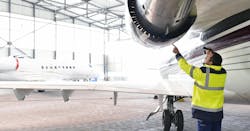The Business of Biz-Jet Maintenance in Latin America
“This is a very large and diverse region, so there are certain areas that have a stronger, more robust MRO climate than others,” says Francisco Zozaya, president of Jet Support Services, Inc. (JSSI) Latin America and senior vice president, business development and strategy. The JSSI leader goes on to explain, “Maintenance support for turboprop through mid-size business jets is most common in the region and, therefore, it is more competitive. There are fewer technicians trained in larger, long-range business jets in this region. The shops that are most successful specialize in certain airframes and build their reputation through dependable service.”
Gulfstream reports to have approximately 230 aircraft based in Latin America. The three largest fleets are in Mexico with 100 aircraft, Brazil having 40 aircraft and Venezuela with 27. More than half of the approximately 40 Gulfstream aircraft in Brazil are based in São Paulo and Rio de Janeiro and more than a third operate out of Congonhas and Galeão.
The large cabin OEM has four company-authorized warranty facilities (AWFs) where the biggest Gulfstream fleets in Latin America are located: Aero Rio Táxi Aéreo and Líder Aviação in Brazil, Aerovics, S.A. in Mexico, and Aerocentro de Servicios, C.A. in Venezuela. Both of the Brazilian AWFs are recent additions to Gulfstream’s worldwide network. Líder has an operation at São Paulo’s Congonhas Airport, along with facilities in Rio de Janeiro, Belo Horizonte, and Brasilia, while Aero Rio is based at Galeão International Airport in Rio de Janeiro. Líder is also a Gulfstream-authorized parts dealer for South America and can facilitate parts sales transactions to support both scheduled and unscheduled maintenance events in the region.
Currently, they have two field service representatives (FSRs) along with a parts sales representative in Brazil and one FSR in Mexico. Gulfstream says that most customers who visit their AWFs are from the region.
Bill Molloy, vice president, aftermarket sales, Bombardier Business Aircraft, says of maintenance support in the region: "We have four Authorized Service Facilities (ASFs) located across Latin America, as well as FSRs located across the region to support Bombardier customers and ASFs.”
The Parts Challenge – Logistics, Fees, Taxes
Regarding challenges specific to the region, Bombardier’s Molloy goes on to say, “Across the industry, bringing parts into the region can be a challenge and expensive for customers given the import fees, taxes and broker fees. Delays are encountered depending on the country being shipped to and we do our best to keep our customers abreast of any changes to their anticipated shipment times.”
JSSI’s Zozaya agrees and says, “The major challenges facing this region are focused on logistics. The logistics of getting parts into the region in a timely manner can be a major task because of various customs delays”. He goes on to say that customs officials in much of the region typically work Monday through Friday with limited shift work and an aircraft part can sometimes be held up for days with customs handling interruptions. This significant challenge obviously makes it very difficult for aircraft-on-ground (AOG) situations.
Gulfstream describes a very similar situation that affects maintenance support in the region, high taxes and import costs, as well as a somewhat complex customs process that affects the import and export of parts and materials.
Zozaya adds, “The additional costs related to shipping parts into another country, taxes on import parts, customs fees, exchange rates, and policies with different currencies, can impact a facility’s ability to make any profit on parts as well as stay competitive with the repair costs.”
The Talent Shortage Knows No Borders
"Retaining skilled technicians is challenging for MRO shops throughout Latin America, as it is in many parts of the world. The impact appears the same; more training, focus on retaining entry-level technicians for a longer-term approach, highly skilled technicians get recruited by the OEM’s facilities, or other related industries needing the skills of an experienced technician. There are some proactive programs and schools in Mexico associated with MROs and OEMs that help fund and support them in order to get trained technicians into their shops. But we need more," Zozaya explains.
"We also need to see more improvement in the entire A&P pay scale around the world that aligns more with the job responsibilities and technical skills needed to work on today’s modern aircraft with advanced digital systems," Zozaya says. The industry has evolved into a hi-tech business but salaries for aircraft technicians have remained stagnant.”
Maintain in the US
A popular maintenance option for owners and operators having business-jets based in Latin America are taking them to facilities located in the United States. Gulfstream operators in Latin America are able to use the company’s service center at Florida’s Palm Beach International Airport. In the first quarter of 2020, Gulfstream Palm Beach is scheduled to begin operations at a new state-of-the-art, nearly 115,000-sq-ft facility.
Operators may also opt to visit Savannah, Ga., where Gulfstream is opening a 202,000-sq-ft service center expansion at Savannah/Hilton Head International Airport in September and will soon have a more than 1 million square-foot dedicated customer-support building with hangar space, offices, and back shops.
Gulfstream opened the Sorocaba service center in 2012 to address the maintenance requirements of its growing fleet in South America, but it became apparent most operators there preferred to bring their aircraft to Savannah and/or Palm Beach facilities for scheduled maintenance work.
Bombardier agrees and says customers based in Latin America have easy access to the Bombardier Service Center in Fort Lauderdale, Florida. Bombardier’s Service Centers in Florida, Texas, Kansas, and Arizona are also convenient service points for many Latin American customers.
Conclusion
Bombardier concludes by saying their ability to successfully support customers based in the Latin American region is two-fold: providing customers with access to technical expertise through their Customer Response Center hotline and having long-standing FSRs based locally throughout the region.
Gulfstream agrees and says that it’s best to have an in-country partner to help reduce the time it takes to get needed materials into the country. Being flexible is very important. You have to be flexible to accommodate a constantly changing customer base and support requirements.
JSSI’s Zozaya adds: “Some might think they should consider stocking more parts in the region, but this is not a feasible solution because of the vastness of parts needed and basic demand and supply metrics that don’t support the economics of stocking parts. Therefore, the region has to depend on the OEM parts network of facilities that are based in major hubs in the U.S. and Europe.”
Business and General Aviation Aircraft
The General Aviation Manufactures Association (GAMA) 2018 Annual Report states that in 2017 there were a total of 24,256 general and business aviation aircraft registered in the South American country of Brazil. The breakdown of aircraft types is:
Piston engine – 16,446
Turbo prop – 1,858
Jet turbine – 2,507
Rotorcraft – 2,590
Sailplanes – 609
Other aircraft categories were not reported.
Other Latin American countries were not mentioned in this report.
About the Author
Ronald Donner
Aviation Consultant | AMT
Ronald (Ron) Donner has spent his entire life devoted to aviation and he holds FAA certificates as an A&P/IA, and a Commercial Pilot with Single and Multi Engine Land, Instrument Airplane and Glider ratings. Ron has worked in a variety of maintenance related roles, both technical and management in general aviation as well as with a major airline. Ron was the recipient of the 2012 National Air Transportation Association (NATA) Aviation Journalism award.
Contact: Ron Donner
Chief Editor | Aircraft Maintenance Technology
+1-612-670-6048
>> To download the AviationPros media kits, visit: Marketing Resource Center
>>Check out our aviation magazines: Ground Support Worldwide | Airport Business | Aircraft Maintenance Technology

